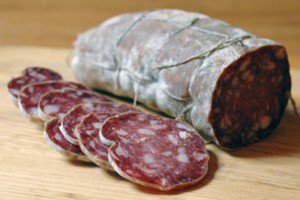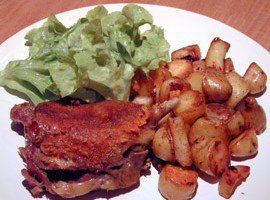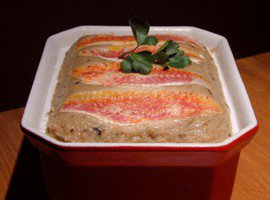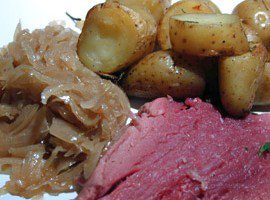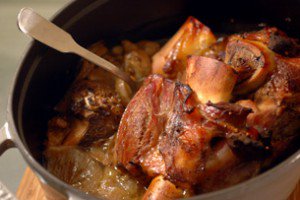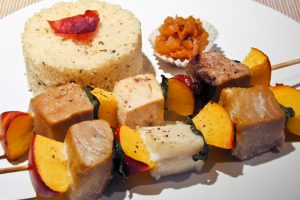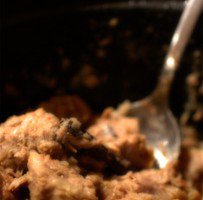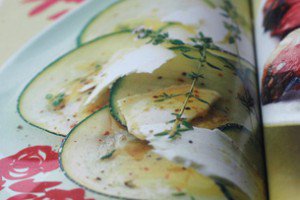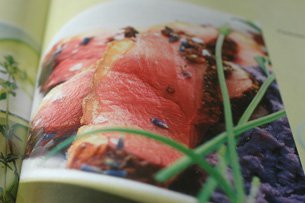
[Lavender-crusted Duck Magret]
As promised, here is the recipe for the main course in the flower menu I created for the French edition of ELLE (issue #3154, June 12, 2006). My thanks to Catherine Roig for allowing me to reproduce the recipes here. The picture above is a shot of the magazine page: the food styling is by Valérie Lhomme, the photography by Edouard Sicot.
Where does one find lavender flowers? The important thing is to use unsprayed lavender flowers: these can be purchased from gourmet stores and spice specialists. In Paris, you will find them at Izrael (30 rue François-Miron in the 4th) or Le Comptoir Colonial (22 rue Lepic in the 18th) for instance. (Lavender also grows very well on a window sill, but you should be aware that it tends to die a horrible death if the facade of your building gets repainted.) If you can’t find lavender flowers, substitute unsprayed thyme flowers, or omit them and make the spice rub with 3 teaspoons cumin seeds and 3 teaspoons coriander seeds.
What is the difference between a duck fillet and a duck magret? Both refer to one half of a duck breast, but magrets come from a duck that’s been force-fed to make foie gras, whereas fillets come from regular ducks. Magrets are more flavorful, but fattier than fillets.
For the rest of the menu, see:
~ Zucchini poppy carpaccio,
~ Raspberry and violet tartlets.
Magret en Croûte de Lavande
2 duck fillets or magrets, about 400 grams (14 ounces) each
4 teaspoons unsprayed dried lavender flowers (check with the vendor that the lavender is safe for consumption)
2 teaspoons whole cumin seeds
2 teaspoons whole coriander seeds
The zest of one lemon, finely chopped
2 teaspoons fleur de sel
1/2 teaspoon freshly ground pepper
Serves 4.
Slash a few diagonal cuts in the skin of the meat. Combine the rest of the ingredients in a small mortar or spice grinder, and pestle or process until finely ground. Sprinkle this rub on the flesh side of the meat, wrap each piece tightly in plastic, and chill for an hour.
Remove the meat from the fridge 15 minutes before serving. Preheat the oven to 200° C (400° F), and place the fillets or magrets (without the plastic wrap!) skin side down in a baking dish. Slip into the oven to bake for 15 minutes, flip the meat, and return into the oven for 5 minutes. If desired, you can switch the oven to grill mode at this point to get the skin crispy and golden.
Transfer the meat on a cutting-board, and reserve the cooking juices. Cover the meat with foil, and let rest for 5 minutes. Cut each fillet in 1-cm (1/2-inch) slices, drizzle with the juices, and serve with mashed purple potatoes.
What do I do with the remaining lavender? You can use it to make a soothing bedtime tisane, or use it sparingly in a compote of apricots, peaches, or pears. To make lavender sugar, grind together 1 tablespoon lavender with 1 cup sugar, and sprinkle on faisselle, yogurt, or crêpes.


